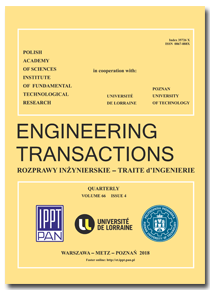10.24423/ENGTRANS.203.2008
Rigid Body Assembly Impact Models for Adiabatic Cutoff Equipments
References
S. Abrate, Modeling of impacts on composite structures, Composite structures, 51, 2, 129–138, 2001.
A.-S. Bonnet-Lebouvier, A. Molinari and P. Lipinski, Analysis of the dynamic propagation of adiabatic shear bands, International Journal of Solids and Structures, 39, 16, 4249–4269, 2002.
T. J. Burns and M. A. Davies, On repeated adiabatic shear band formation during high-speed machining, International Journal of Plasticity, 18, 1, 487–506, 2002.
X. W. Chen, Q. M. Li and S. C. Fan, Initiation of adiabatic shear failure in a clamped circular plate struck by a blunt projectile, International Journal of Impact Engineering, 31, 7, 877–893, 2005.
A. Eberle, D. Klingbeil and J. Schicker, The calculation of dynamic jR-curves from the finite element analysis of a Charpy test using a rate-dependent damage model, Nuclear Engineering and Design, 198, 1–2, 75–87, 2000.
A. L. Gurson, Continuum theory of ductile rupture by void nucleation and growth: Part I, yield criteria and flow rules for porous media, Journal of Engineering Materials and Technology, 99, 2–15, 1977.
J. R. Klepaczko, Review on critical impact velocities in tension and shear, International Journal of Impact Engineering, 32, 1–4, 188–209, 2005.
G. W. Luo, Dynamics of an impact-forming machine, International Journal of Mechanical Sciences, 48, 11, 1295–1313, 2006.
S. S. Rao, Mechanical vibrations, Second edition, Addison-Wesley Publishing Company, 1990.
K. M. Roessig and J. J. Mason, Adiabatic shear localization in the dynamic punch test, part I: experimental investigation, International Journal of Plasticity, 15, 3, 241–262, 1999.
K. M. Roessig and J. J. Mason, Adiabatic shear localization in the dynamic punch test, part II: numerical simulations, International Journal of Plasticity, 15, 3, 263–283, 1999.
K. N. Shivakumar, W. Elber and W. Illg, Prediction of impact force and duration due to low velocity impact on circular composite laminates, ASME, 52, 674–680, 1985.
W. J. Stronge, Impact Mechanics, Cambridge University Press, Cambridge 2000.
X. Teng, T. Wierzbicki and H. Couque, On the transition from adiabatic shear bending to fracture, Mechanics of Materials, 39, 2, 107–125, 2007.
S. Timoshenko and N. Goodier, Theory of elasticity, 3rd edition, McGraw-Hill, NewYork 1970.
DOI: 10.24423/ENGTRANS.203.2008




